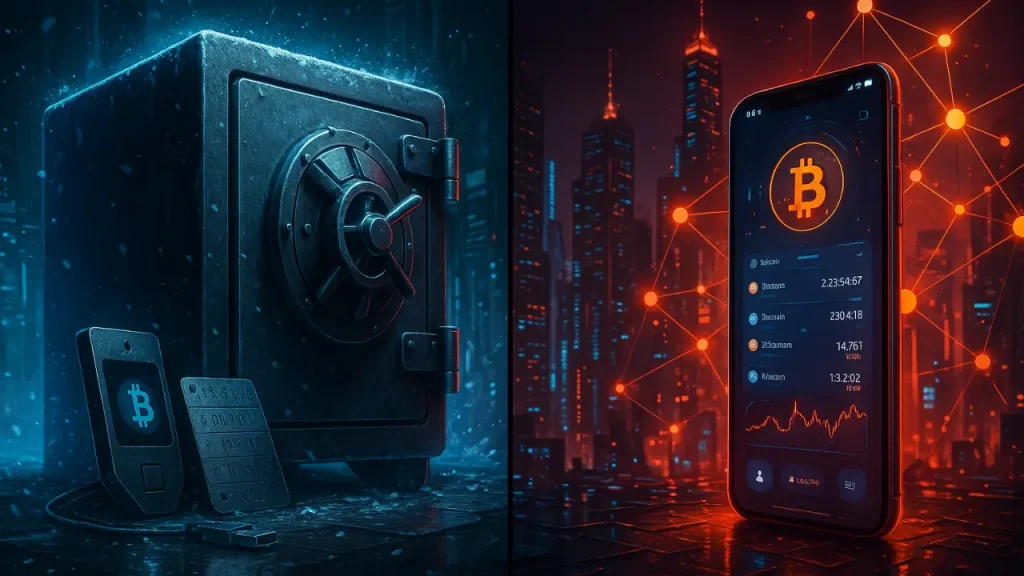If you hold for months or years, prefer cold storage. If you trade daily or interact with dApps, use a hot wallet with strict limits. For a one-page takeaway, Download: Cold Storage Vs Hot Wallet — Step-by-Step Checklist (PDF). Keep long-term funds offline, keep spending money online, and never mix roles on one device.
- Separate “vault” money from “spending” money across wallets.
- Use hardware wallets or paper backups for vaults.
- Keep hot wallet balances small and rotate addresses.
- Record recovery phrases offline and test restores before funding.
What you’re deciding: cold storage vs hot wallet
The phrase cold storage vs hot wallet describes a trade between convenience and attack surface. Cold storage keeps private keys offline, which blocks most remote attacks. It adds friction when you move funds. Hot wallets keep keys on an internet-connected device. That speed enables trading and dApp activity, yet invites phishing and malware risks. The best setup uses both, with clear roles and spending limits that fit your goals.
New to wallet vocabulary? Start with our Beginners hub, then come back to design your storage plan. If you prefer guided walkthroughs, browse our How-To Tutorials and print their checklists from Downloads.
How cold storage works
Cold storage means your private keys never touch the internet. The classic approach is a hardware wallet that signs transactions inside a secure element. You verify details on a device screen before approving. Other forms include paper wallets and air-gapped machines. All rely on one concept. Attackers cannot keylog or inject if the signing key never connects. Cold setups add ceremony. You must plug in a device, confirm addresses, and store recovery phrases safely. Good friction protects capital and slows costly mistakes.
Security is only as strong as your backups. Write the recovery phrase on durable media. Store duplicates in separate locations. Consider a metal backup for fire and flood resilience. Test a dry-run restore before funding the wallet. If you manage large balances or corporate funds, evaluate multisig. Multisig can distribute signing approval across people or devices, reducing single-point failure.
How hot wallets work
Hot wallets live in browsers or mobile apps and keep keys on connected devices. They shine when speed matters, like trading or minting. Approvals flow quickly and integrate with exchanges, bridges, and DeFi protocols. The trade-off is a larger attack surface. Phishing websites, malicious extensions, clipboard hijackers, and SIM-swap attacks all target hot users. Good hygiene reduces the odds. Use a fresh, minimal browser profile, lock the wallet, and verify every site’s URL.
Hot setups benefit from separation. Keep one wallet for experimentation with tiny balances. Keep a second for regular activity with moderate limits. Treat both as “spending” layers. Top them up from cold storage in small batches. Sweep profits back to cold storage on a schedule. Never import your cold seed into a hot app.
Security, privacy, and risk trade-offs
Cold storage minimizes online exposure and limits adversaries to physical attacks. Device theft, shoulder surfing, and social engineering remain concerns. Hot wallets invite remote threats but can be hardened. Phishing drills and URL allowlists go far. So does keeping balances small. Privacy differs as well. Cold flows are infrequent and easier to plan with coin control tools. Hot flows are frequent and may leak patterns. Avoid reusing addresses where possible and consider fresh receiving addresses for each payment.
Threats evolve. Always verify firmware authenticity for hardware devices and extensions. Read device screens, not browser pop-ups, for destination checks. Keep a non-custodial mindset even when using custodial on-ramps. Withdraw to your wallets promptly. Document your process and store it offline where you keep backup seeds.
Costs, convenience, and when to use which
Cold storage has upfront costs for hardware and metal backups. It adds time costs when moving funds. Hot wallets are free or cheap, but the real cost is risk. Balance the two by mapping your goals. Long-term holders and treasuries prioritize safety and audit trails. Daily traders and NFT users prioritize speed and app support. Many users adopt a 90/10 split. Ninety percent of value lives in cold storage. Ten percent fuels activity across exchanges and dApps. Rebalance monthly or when balances drift above comfort.
Consider family or team access. Cold storage supports inheritance and authorization plans. You can store instructions with attorneys or trusted executors. Hot wallets are personal tools with fast switching but weak survivability. Label addresses and keep an inventory. Simple documentation prevents panic during emergencies and travel.
Practical setup patterns and best practices
Base layout: one hardware wallet as a vault, one mobile hot wallet for daily use, and a clean browser wallet for dApps. Seed hygiene: write seeds offline, never photograph them, and use duplicate backups stored apart. Device hygiene: update firmware from official channels and verify checksums where offered. Transaction hygiene: whitelist known addresses and test with tiny sends first. Process hygiene: schedule quarterly drills to restore from seed onto a spare device, then wipe it.
Use our tools list to review recommended software and signing devices on one page: Tools. When you finish designing your layout, print the summary and store it with your backups. Finally, grab the single-page checklist here: Download: Cold Storage Vs Hot Wallet — Step-by-Step Checklist (PDF).
| Dimension | Cold storage | Hot wallet |
|---|---|---|
| Primary use | Long-term holding, treasury, inheritance planning | Daily spending, trading, dApps, NFTs |
| Key exposure | Offline; hardware-isolated signing | Online; OS and browser exposed |
| Attack surface | Physical theft, social engineering, seed loss | Phishing, malware, SIM-swap, malicious sites |
| Speed & UX | Deliberate, slower approvals | Fast approvals and rich integrations |
| Cost | Hardware + metal backup, time to move funds | Low upfront; risk cost if hygiene is weak |
| Good practice | Multisig, off-site backups, dry-run restores | Small balances, address book, fresh profiles |
Last updated: 2025-08-24
FAQ
Should I keep all my crypto in cold storage?
No. Keep long-term funds cold and small working balances hot. Separate roles and never import cold seeds into hot apps.
Is a hardware wallet the same as cold storage?
Usually yes. Hardware wallets sign offline and keep keys off your computer. You still need strong backups and firmware hygiene.
Are mobile wallets safe?
They are convenient with proper hygiene. Lock the app, disable unknown links, and keep balances small. Treat phones as hot devices.
What is the biggest risk with hot wallets?
Phishing and malicious approvals. Always read the device or wallet details, verify domain spelling, and start with tiny test transactions.
How can I reduce the risk of seed loss?
Use two geographically separated backups, consider metal plates, and test a full restore. Store instructions for trusted heirs.
When should I consider multisig?
Use multisig for large treasuries, shared custody, or corporate governance. It reduces single-point failure at the cost of complexity.
Final CTA: For a printable one-pager and quick chooser, Download: Cold Storage Vs Hot Wallet — Step-by-Step Checklist (PDF).
Sources & references
- Bitcoin.org — Securing your wallet
- Ethereum.org — Security and scam prevention
- Ledger Academy — What is a hardware wallet?
- Trezor Learn — What is a hardware wallet?
- Coinbase Learn — What is a crypto wallet?
Important disclaimer
Important: The information on this page is for educational purposes only and does not constitute investment advice. The views expressed reflect the authors’ opinions. Always do your own research and make decisions based on your personal circumstances — you are solely responsible for your funds and risks. Act with caution and protect your capital.



